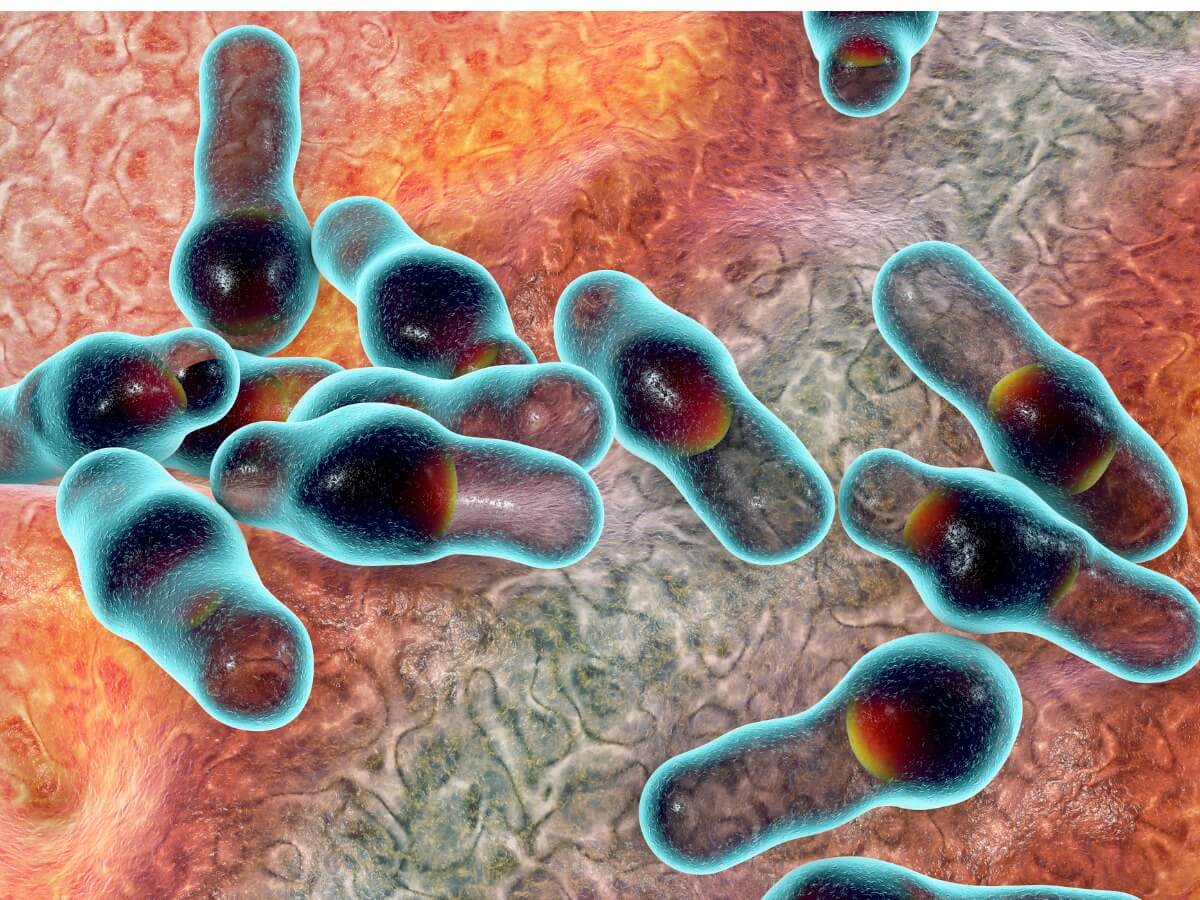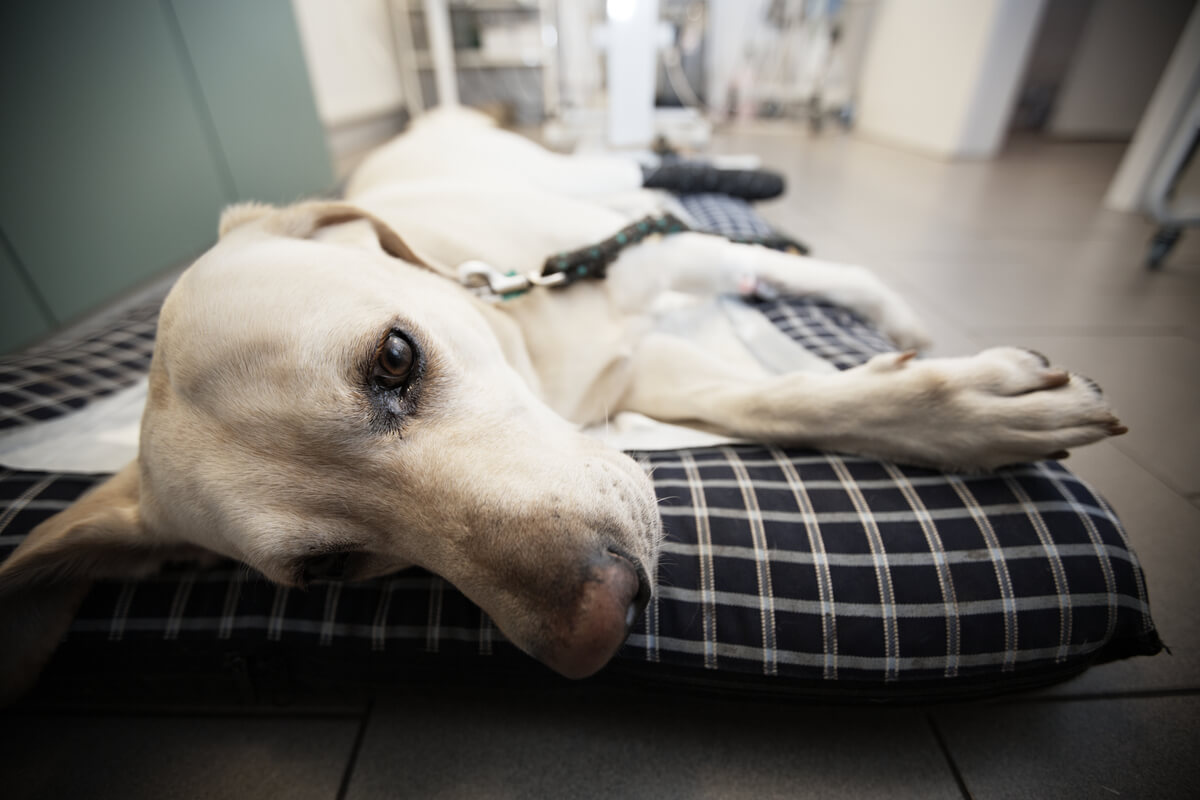Botulism in Dogs: Characteristics, Causes and Treatment


Written and verified by the biologist Samuel Sanchez
Botulism in dogs is a type of poisoning caused by the bacterium Clostridium botulinum. This pathogen can affect several vertebrates – including humans – but, in dogs, it’s almost always transmitted by the ingestion of dead animals or the consumption of infected raw meat.
This condition is rare in dogs, but it has caused significant economic losses in the poultry sector during epidemic outbreaks and, in humans, its mortality rate is 10%. If you want to learn how to detect this type of food poisoning in dogs, you’re in the right place.
What is botulism in dogs?
First of all, it should be noted that botulism is poisoning, not an infection. The medical condition develops when the person or animal ingests the toxin when it has been synthesized by the bacterial spores of Clostridium botulinum, and not by the consumption of the pathogen itself. Although, in some cases, the bacteria are ingested and produce the toxin in the intestine, it isn’t common.
When dogs eat dead animals and contaminated meat, the toxin is absorbed from the gut and enters the bloodstream. The harmful compound travels systemically and attaches itself to nerve endings in animals, generating a series of characteristic symptoms.
This type of food poisoning has also been detected in our species, as well as ducks, pheasants, chickens, minks, cows and horses, among other animals. There are 7 types of C. botulinum — from A to G. Types A, B, and E affect people, while most mammals and birds are infected with C1, including dogs.

Pathological mechanism
When exploring the etiology of this condition, it’s useful to briefly touch on the particularities of the compound that concerns us. As scientific studies indicate, Botulinum toxin (BoNT) is the most potent and harmful natural toxin discovered to date.
Clinically, this toxic protein binds irreversibly to presynaptic nerve endings. This causes the blockage of the release of acetylcholine, a neurotransmitter that modulates nerve transmission in dogs and other animals. As a consequence, a total and temporary denervation occurs and the animal’s muscles stop responding.
Symptoms of botulism in dogs
The symptoms of botulism in dogs are a direct consequence of muscle paralysis caused by the ingested toxin. Among the most important systemic effects, we can highlight the following:
- Diarrhea and vomiting
- Excessive saliva production (hypersalivation)
- Abdominal pain
- Weakness that gets worse very quickly.
- Paralysis that begins in the hind limbs and then spreads
- Vision problems
- Difficulty biting and swallowing
- Decreased heart rate
- Severe trouble breathing
Symptoms can appear from hours to days after the ingestion of the toxin, as indicated by the VCA Hospitals portal. The severity of the condition will depend on the amount of botulinum toxin ingested and, the sooner the paralysis appears, the worse the prognosis.
Symptoms can appear up to 6 days after eating rotten meat.
Causes
As we have said, this condition is poisoning, not an infection. Therefore, the dog doesn’t need to consume the bacteria: it’s enough for them to ingest a minimal amount of botulinum toxin to become really ill.
C. botulinum is a soil bacterium. Furthermore, their resistance spores can survive for a long time in humid environments and are very difficult microorganisms to kill. This bacterial species is distributed throughout the world and it can be assumed that it grows on practically any food surface, be it animal or plant.
In the case of canids, the most common contact between the bacteria and the animal is after the consumption of raw meat, especially if it’s decomposing in the natural environment. Special care must be taken if the dog hunts or kills wild birds, as botulism is much more common in ducks and poultry than in other animals.
Diagnosis
This condition is very rare in dogs, but when it has been detected, it has been found that C. botulinum C1 and D types are the most common causes. If you notice any of the above symptoms 12 to 36 hours after your dog has eaten raw, untreated meat, then hurry to the vet.
The professional will suspect botulism if the owner describes a fast-onset motor paralysis in the animal. However, this pathology can be confused with many others — poison consumption, central nervous system (CNS) infection, spinal injuries, and more — so the diagnosis can be quite complicated.
In these cases, it’s always necessary to obtain samples of the animal’s blood, feces, vomit and urine. The purpose of this collection is to carry out laboratory tests that detect the presence of the toxin. Still, because it causes symptoms at extremely low levels, tests can sometimes be negative even though the dog is intoxicated.
In some cases, vets only diagnose botulism in dogs after ruling out any pathology of the nervous system.
Treatment of botulism in dogs
If you suspect that your dog has consumed infected meat, and it still isn’t showing any symptoms, then it’s possible to administer an antitoxin. This prevents botulinum toxin from adhering to nerve endings and prevents connections; in this way you can avoid the full effects of the poisoning. However, if the clinical signs have already appeared, the antitoxin is of no use.
In the event that paralysis has already set in, there’s no cure. The only possible care is supportive: intravenous fluid therapy, respiratory assistance, urinary catheters and other devices that facilitate the physiological needs of the dog. Over time, the symptoms and paralysis should decrease.

Forecast
Most dogs regain physiological normality within 14 to 24 days if they receive appropriate emergency care. However, without hospital admission, the most likely outcome is death, either due to respiratory paralysis or cardiac dysfunction.
If your dog has consumed raw meat while out for a walk and you suspect that they may have ingested botulinum toxin, then go to the vet to see if an antitoxin is possible as a preventive measure. In health matters, prevention is always better than cure.
Botulism in dogs is a type of poisoning caused by the bacterium Clostridium botulinum. This pathogen can affect several vertebrates – including humans – but, in dogs, it’s almost always transmitted by the ingestion of dead animals or the consumption of infected raw meat.
This condition is rare in dogs, but it has caused significant economic losses in the poultry sector during epidemic outbreaks and, in humans, its mortality rate is 10%. If you want to learn how to detect this type of food poisoning in dogs, you’re in the right place.
What is botulism in dogs?
First of all, it should be noted that botulism is poisoning, not an infection. The medical condition develops when the person or animal ingests the toxin when it has been synthesized by the bacterial spores of Clostridium botulinum, and not by the consumption of the pathogen itself. Although, in some cases, the bacteria are ingested and produce the toxin in the intestine, it isn’t common.
When dogs eat dead animals and contaminated meat, the toxin is absorbed from the gut and enters the bloodstream. The harmful compound travels systemically and attaches itself to nerve endings in animals, generating a series of characteristic symptoms.
This type of food poisoning has also been detected in our species, as well as ducks, pheasants, chickens, minks, cows and horses, among other animals. There are 7 types of C. botulinum — from A to G. Types A, B, and E affect people, while most mammals and birds are infected with C1, including dogs.

Pathological mechanism
When exploring the etiology of this condition, it’s useful to briefly touch on the particularities of the compound that concerns us. As scientific studies indicate, Botulinum toxin (BoNT) is the most potent and harmful natural toxin discovered to date.
Clinically, this toxic protein binds irreversibly to presynaptic nerve endings. This causes the blockage of the release of acetylcholine, a neurotransmitter that modulates nerve transmission in dogs and other animals. As a consequence, a total and temporary denervation occurs and the animal’s muscles stop responding.
Symptoms of botulism in dogs
The symptoms of botulism in dogs are a direct consequence of muscle paralysis caused by the ingested toxin. Among the most important systemic effects, we can highlight the following:
- Diarrhea and vomiting
- Excessive saliva production (hypersalivation)
- Abdominal pain
- Weakness that gets worse very quickly.
- Paralysis that begins in the hind limbs and then spreads
- Vision problems
- Difficulty biting and swallowing
- Decreased heart rate
- Severe trouble breathing
Symptoms can appear from hours to days after the ingestion of the toxin, as indicated by the VCA Hospitals portal. The severity of the condition will depend on the amount of botulinum toxin ingested and, the sooner the paralysis appears, the worse the prognosis.
Symptoms can appear up to 6 days after eating rotten meat.
Causes
As we have said, this condition is poisoning, not an infection. Therefore, the dog doesn’t need to consume the bacteria: it’s enough for them to ingest a minimal amount of botulinum toxin to become really ill.
C. botulinum is a soil bacterium. Furthermore, their resistance spores can survive for a long time in humid environments and are very difficult microorganisms to kill. This bacterial species is distributed throughout the world and it can be assumed that it grows on practically any food surface, be it animal or plant.
In the case of canids, the most common contact between the bacteria and the animal is after the consumption of raw meat, especially if it’s decomposing in the natural environment. Special care must be taken if the dog hunts or kills wild birds, as botulism is much more common in ducks and poultry than in other animals.
Diagnosis
This condition is very rare in dogs, but when it has been detected, it has been found that C. botulinum C1 and D types are the most common causes. If you notice any of the above symptoms 12 to 36 hours after your dog has eaten raw, untreated meat, then hurry to the vet.
The professional will suspect botulism if the owner describes a fast-onset motor paralysis in the animal. However, this pathology can be confused with many others — poison consumption, central nervous system (CNS) infection, spinal injuries, and more — so the diagnosis can be quite complicated.
In these cases, it’s always necessary to obtain samples of the animal’s blood, feces, vomit and urine. The purpose of this collection is to carry out laboratory tests that detect the presence of the toxin. Still, because it causes symptoms at extremely low levels, tests can sometimes be negative even though the dog is intoxicated.
In some cases, vets only diagnose botulism in dogs after ruling out any pathology of the nervous system.
Treatment of botulism in dogs
If you suspect that your dog has consumed infected meat, and it still isn’t showing any symptoms, then it’s possible to administer an antitoxin. This prevents botulinum toxin from adhering to nerve endings and prevents connections; in this way you can avoid the full effects of the poisoning. However, if the clinical signs have already appeared, the antitoxin is of no use.
In the event that paralysis has already set in, there’s no cure. The only possible care is supportive: intravenous fluid therapy, respiratory assistance, urinary catheters and other devices that facilitate the physiological needs of the dog. Over time, the symptoms and paralysis should decrease.

Forecast
Most dogs regain physiological normality within 14 to 24 days if they receive appropriate emergency care. However, without hospital admission, the most likely outcome is death, either due to respiratory paralysis or cardiac dysfunction.
If your dog has consumed raw meat while out for a walk and you suspect that they may have ingested botulinum toxin, then go to the vet to see if an antitoxin is possible as a preventive measure. In health matters, prevention is always better than cure.
All cited sources were thoroughly reviewed by our team to ensure their quality, reliability, currency, and validity. The bibliography of this article was considered reliable and of academic or scientific accuracy.
- Košenina S, Masuyer G, Zhang S, Dong M, Stenmark P (June 2019). “Crystal structure of the catalytic domain of the Weissella oryzae botulinum‐like toxin”. FEBS Letters. 593 (12): 1403–1410.
- Botulism in dogs, VCA Hospitals. Recogido a 14 de julio en https://vcahospitals.com/know-your-pet/botulism-in-dogs
This text is provided for informational purposes only and does not replace consultation with a professional. If in doubt, consult your specialist.








